#durum wheat semolina
Photo

Homemade Farfalle Pasta
To make farfalle bow ties out of real Italian pasta at home, all you need is flour and water.
0 notes
Photo
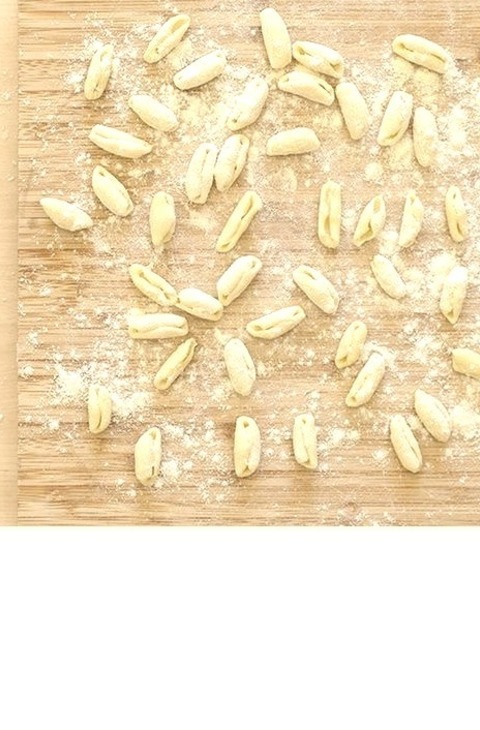
Homemade Cavatelli Pasta Recipe
Learn how to make cavatelli, a typical Southern Italian pasta, with this authentic Italian recipe and video. You will only need durum wheat semolina flour, water, and salt.
0 notes
Photo
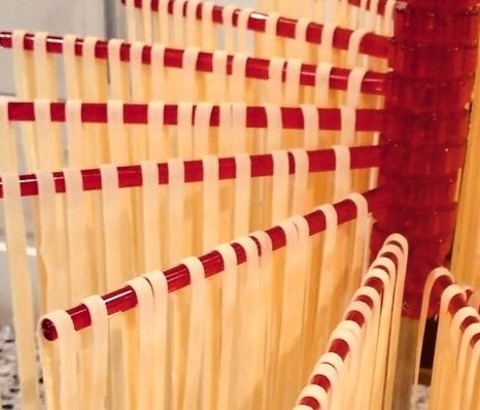
Homemade Semolina Pasta Dough
This is a recipe for durum wheat semolina flour-based traditional Italian pasta dough. The dough can be used to make ravioli, farfalle, or tagliatelle, among other types of pasta.
0 notes
Photo
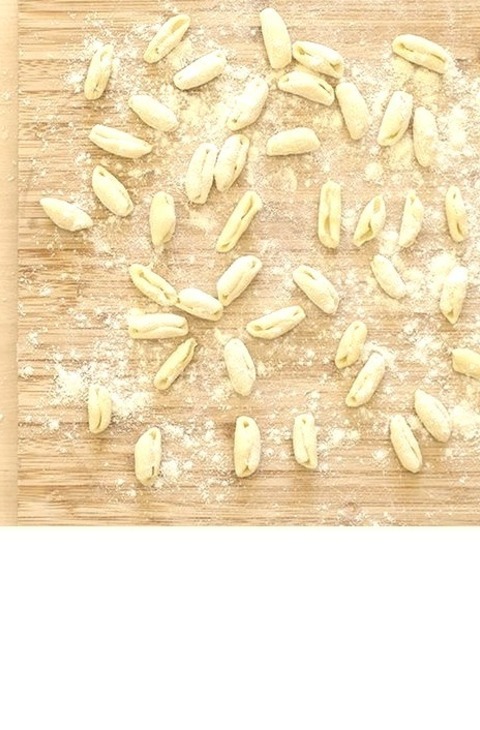
Homemade Cavatelli Pasta
With the help of this real Italian recipe and video, you can learn how to make cavatelli, a common Southern Italian pasta. Only durum wheat semolina flour, water, and salt are required.
0 notes
Photo
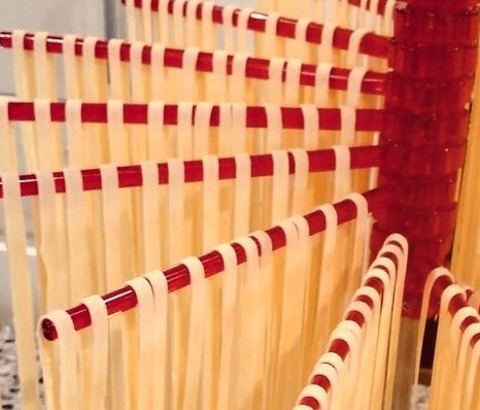
Italian - Homemade Semolina Pasta Dough
This is a recipe for durum wheat semolina flour-based traditional Italian pasta dough. The dough can be used to make ravioli, farfalle, or tagliatelle, among other types of pasta.
0 notes
Text

[ID: Two plates of cookies, one oval and topped with powdered sugar, and the others shaped in rings; one cookie is broken in half to show a date filling; two glasses of coffee on a silver tray are in the background. End ID]
معمول فلسطيني / Ma’moul falastini (Palestinian semolina cookies)
Ma’moul (also transliterated “ma’amoul,” “maamoul” and “mamoul”) are sweet pastries made with semolina flour and stuffed with a date, walnut, or pistachio filling. The cookies are made tender and crumbly with the addition of fat in the form of olive oil, butter, or clarified butter (سمن, “samn”); delicate aromatics are added by some combination of fennel, aniseed, mahlab (محلب: ground cherry pits), mastic gum (مستكه, “mistīka”), and cinnamon.
“مَعْمُول” means “made,” “done,” “worked by hand,” or “excellently made” (it is the passive participle of the verb “عَمِلَ” “‘amila,” "to do, make, perform"). Presumably this is because each cookie is individually filled, sealed, and shaped by hand. Though patterned molds known as طوابع (“ṭawābi’,” “stamps”; singular طابع, “ṭābi’”) are sometimes used, the decorations on the surface of the cookies may also be applied by hand with the aid of a pair of small, specialized tongs (ملقط, “milqaṭ”).
Because of their laborious nature, ma’moul are usually made for feast days: they are served and shared for Eid, Easter, and Purim, a welcome reward after the Ramadan or Lenten fasts. For this reason, ma’moul are sometimes called “كَعْك العيد” (“ka’k al-’īd,” “holiday cakes”). Plates of the cookies, whether homemade or store-bought, are passed out and traded between neighbors in a practice that is part community-maintenance, part continuity of tradition, and part friendly competition. This indispensable symbol of celebration will be prepared by the women of a family even if a holiday falls around the time of a death, disaster, or war: Palestinian food writer Laila El-Haddad explains that "For years, we endured our situation by immersing ourselves in cooking, in our routines and the things we could control."
Other names for these cakes exist as well. Date ma’moul–the most common variety in Palestine–may be called كَعْك بعَجْوَة (“ka'k b'ajwa”), “cakes with date paste.” And one particular Palestinian variety of ma’moul, studded with sesame and nigella seeds and formed into a ring, are known as كَعْك أَسَاوِر (“ka'k 'asāwir”), “bracelet cakes.” The thinner dough leads to a cookie that is crisp and brown on the outside, but gives way to a soft, chewy, sweet filling.

[ID: An extreme close-up on one ka'k al-aswar, broken open to show the date filling; ma'moul and a silver teapot are very out-of-focus in the background. End ID]
History
Various sources claim that ma’moul originated in Egypt, with their ancestor, كحك (kaḥk), appearing in illustrations on Pharaonic-era tombs and temples. The more specific of these claims usually refer to “temples in ancient Thebes and Memphis,” or more particularly to the vizier Rekhmire’s tomb in Thebes, as evidencing the creation of a pastry that is related to modern kahk. One writer attests that this tomb depicts “the servants mix[ing] pure honey with butter on the fire,” then “adding the flour by mixing until obtaining a dough easy to transform into forms” before the shaped cookies were “stuffed with raisins or dried dates and honey.” Another does not mention Rekhmire, but asserts that “18th-dynasty tombs” show “how honey is mixed with butter on fire, after which flour is added, turning the substance into an easily-molded dough. These pieces are then put on slate sheets and put in the oven; others are fried in oil and butter.”
Most of these details seem to be unfounded. Hilary Wilson, summarizing the state of current research on Rekhmire’s tomb, writes that the depicted pastries were delivered as an offering to the Treasury of the Temple of Amun; that they certainly contained ground tiger nuts; that they presumably contained wheat or durum flour, since ground tiger nuts alone would not produce the moldable dough illustrated; that the liquid added to this mixture to form the dough cannot be determined, since the inscription is damaged; that the cakes produced “are clearly triangular and, when cooked are flat enough to be stacked” (any appearance that they are pyramidal or conical being a quirk of ancient Egyptian drawing); that they were shallow-fried, not cooked in an oven; and that honey and dates are depicted at the far left of the scene, but their relationship to the pastries is unclear. There is no evidence of the honey being included in the dough, or the cookies being stuffed with dates; instead, Wilson speculates that “It appears that the cooks are preparing a syrup or puree of dates and honey. It is tempting to think that the cakes or pastries were served [...] with a generous portion of syrup poured over them.” Whether there is any direct lineage between these flat, fried pastries and the stuffed, molded, and baked kahk must also be a matter of speculation. [1]
Another origin claim points to ancient Mesopotamia. James David Audlin speculates that ma’moul are "possibly" the cousins of hamantaschen, both being descended from the molded "kamānu cakes that bore the image of [YHWH’s] goddess wife Inanna [also known as Ishtar or Astarte]" that were made in modern-day Syria. Other claims for Mesopotamia cite qullupu as the inspiration: these cakes are described in the contemporary record as wheat pastries filled with dates or raisins and baked. (Food historian Nawal Nasrallah writes that these cookies, which were offered to Ishtar for the new year festival in spring, may also be an origin point for modern Iraqi كليچة, "kleicha.")
The word "määmoul" had entered the English language as a type of Syrian farina cake by 1896.
In Palestine
From its earliest instantiations, Zionist settlement in Palestine was focused on building farming infrastructure from which Palestinians could be excluded: settlers, incentivized by foreign capital, aimed at creating a separate economy based around farms, agricultural schools, communal settlements, and research institutions that did not employ Arabs (though Arab labor and goods were never entirely cut out in practice).
Zionist agricultural institutes in Palestine had targeted the date as a desirable crop to be self-sufficient in, and a potentially profitable fruit for export, by the 1930s. Ben-Zion Israeli (בנציון ישראלי), Zionist settler and founder of the Kinneret training farm, spoke at a 1939 meeting of the Organization of Fruit Growers (ארגון מגדלי פירות) in the Nahalel (נהלל) agricultural settlement to discuss the future of date palms in the “land of Israel.” He discussed the different climate requirements of Egyptian, Iraqi, and Tunisian cultivars—and which among them seemed “destined” (נועדים) for the Jordan Valley and coastal plains—and laid out his plan to collect saplings from surrounding countries for planting despite their prohibitions against such exports.
In the typical mode of Zionist agriculture discourse, this speech dealt in concepts of cultivation as a means of coming into a predestined ownership over the land; eating food suited for the climate as a means of belonging in the land; and a return to Biblical history as a triumphant reclamation of the land from its supposed neglect and/or over-cultivation by Palestinian Arabs over the past 2,000 years. Israeli opened:
נסתכל לעברה של הארץ, אשר אנו רוצים להחיותה ולחדשה. היא השתבחה ב"שבעה מינים" ואלה עשוה אינטנסיבית וצפופת אוכלוסין. לא רק חיטה ושעורה, כי אם גם עצים הנותנים יבול גדול בעל ערך מזוני רב. בין העצים -- הזית [...] הגפן, התאנה והתמר. לשלושה מהם, לזית, לתאנה ולתמר חטאה התישבותנו שאין היא נאחזת בהם אחיזה ציםכר של ממש ואינה מפתחת אותם דים.
We will look to the past of the land [of Israel], which we want to revive and renew. It excelled in "seven species," and these flourished and became densely populated. Not only wheat and barley, but also trees that give a large and nutritious crop. Among the trees: the olive, [...] the vine, the fig and the date. For three of them, the olive, the fig and the date, it is the sin of our settlement that it does not hold on to them with a strong grip and does not develop them.
He continued to discuss the benefits of adopting the date—not then part of the diet of Jewish settlers—to “health and economy” (בריאות וכלכלה). Not only should the “land of Israel” become self-sufficient (no longer importing dates from Egypt and Iraq), but dates should be grown for export to Europe.
A beginning had already been made in the importation of about 8,000 date palm saplings over the past two decades, of which ¾ (according to Israeli) had been brought by Kibbutz Kinneret, and the remaining ¼ by the settlement department of the Zionist Commission for Palestine (ועד הצירים), by the Mandate government's agriculture department, and by people from Degania Bet kibbutz ('דגניה ב). The majority of these imports did not survive. More recently, 1000 smuggled saplings had been planted in Rachel’s Park (גן רחל), in a nearby government plot, and in various places in the Jordan Valley. Farms and agricultural institutions would need to collaborate in finding farmers to plant dates more widely in the Beit-Sha’an Valley (בקעת בית שאן), and work to make dates take their proper place in the settlements’ economies.
These initial cuttings and their descendents survive in large plantations across “Israel” and the occupied Palestinian territories. Taher Herzallah and Tarek Khaill write that “Palm groves were planted from the Red Sea in the south along the Dead Sea, and as far as the Sea of Galilee up north, which has given the Israeli date industry its nickname ‘the industry of the three seas’” Since Israel occupied the Palestinian West Bank in 1967, it has also established date plantations in its illegal settlements in that portion of the Jordan Valley.” Today, these settlements produce between 40 and 60% of all Israeli dates.
In 2022, Israel exported 67,042 tons of dates worth $330.1 million USD; these numbers have been on a steady rise from 4,909 tons worth $1.2m. in 1993. Palestinian farmers and their children, disappropriated from their land and desperate for income, are brought in to date plantations to work for long hours in hazardous conditions for low pay. Workers are lifted into the date palms by cranes where they work, with no means of descending, until the crane comes to lower them down again at the end of the day. Injuries from falls, pesticides, heat stroke, and date-sorting machinery are common.
Meanwhile, settlers work to curtail and control Palestinian production of dates. The Palestinian population in the West Bank and Gaza is used as a pool of cheap labor and a captive market to purchase Israeli imports, absorb excesses in Israeli goods, stabilize Israeli wages, and make up for market deficits. Thus Palestinian date farmers may be targeted with repressive measures such as water contamination and diversion, destruction of wells, crop destruction, land theft, military orders forbidding the planting of trees, settler attacks, closing of checkpoints and forbidding of exports, and the denial of necessary equipment or the means to make it, in part to ensure that their goods do not compete with those of Israeli farmers in domestic or foreign markets. Leah Temper writes that these repressive measures are part of a pattern whereby Israel tries to “stop [Palestinian] growth in high value crops such as strawberries, avocados and dates, which are considered to be ‘Israeli Specialties’.”
At other times, Palestinian farmers may be ordered to grow certain crops (such as strawberries and dates), and forbidden to grow anything else, when Israeli officials fear falling short of market demand for a certain good. These crops will be exported by Israeli firms, ensuring that the majority of profits do not accrue to Palestinians, and that Palestinians will not have the ability to negotiate or fulfill export contracts themselves. Nevertheless, Palestinian farmers continue to defy these oppressive conditions and produce dates for local consumption and for export. Zuhair al-Manasreh founded date company Nakheel Palestine in 2011, which continues production despite being surrounded by Israeli settlements.
Boycotts of Israeli dates have arisen in response to the conditions imposed on Palestinian farmers and workers. Herzallah and Khaill cite USDA data on the effectiveness of boycott, pressure, and flyering campaigns initiated by groups including American Muslims for Palestine:
Israel’s exports of dates to the US have dropped significantly since 2015. Whereas 10.7 million kilogrammes (23.6 million pounds) of Israeli dates entered the US market in 2015-2016, only 3.1 million kilogrammes (seven million pounds) entered the US market in 2017-2018. The boycott is working and it is having a detrimental effect on the Israeli date industry.
Date products may not be BDS-compliant even if they are not labeled as a product of Israel. Stores may repackage dates under their own label, and exporters may avoid declaring their dates to be a product of Israel, or even falsely label them as a product of Palestine, to avoid boycotts. Purchase California dates, or dates from a known Palestinian exporter such as Zaytoun or Yaffa (not “Jaffa”) dates.
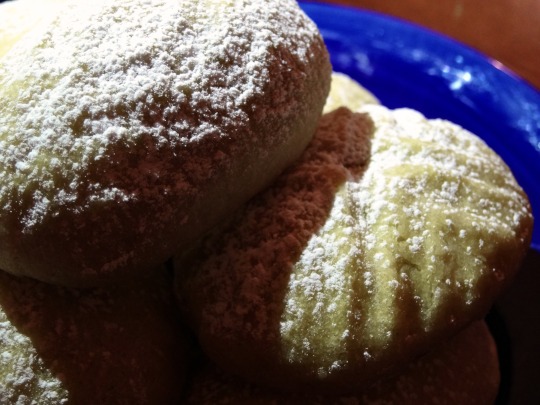
[ID: Close-up of the top of ma'moul, decorated with geometric patterns and covered in powdered sugar, in strong light and shadow. End ID]
Elsewhere
Other efforts to foreground the provenance and political-economic context of dates in a culinary setting have been made by Iraqi Jew Michael Rakowitz, whose store sold ma’moul and date syrup and informed patrons about individual people behind the hazardous transport of date imports from Iraq. Rakowitz says that his project “utilizes food as a point of entry and creates a different platform by which people can enter into conversation.”
[1] Plates from the tomb can be seen in N. de G. Davies, The tomb of Rekh-mi-Rē at Thebes, Vol. II, plates XLVII ff.
Purchase Palestinian dates
Donate to evacuate families from Gaza
Flyer campaign for eSims
Ingredients:
Makes 16 large ma'moul and 32 ka'k al-aswar; or 32 ma'moul; or 64 ka'k al-aswar.
For the dough:
360g (2 1/4 cup) fine semolina flour (سميد ناعم / طحين فرخة)
140g (1 cup + 2 Tbsp) white flour (طحين ابيض)
200g (14 Tbsp) margarine or vegetarian ghee (سمن), or olive oil
2 Tbsp (15g) powdered sugar
1 1/2 Tbsp (10g) dugga ka'k (دقة كعك)
1/2 tsp (2g) instant yeast
About 2/3 cup (190mL) water, divided (use milk if you prefer)
1 tsp toasted sesame seeds (سمسم)
1 tsp toasted nigella seeds (قزحه / حبة البركة)
Using olive oil and water for the fat and liquid in the dough is more of a rural approach to this recipe; ghee and milk (or milk powder) make for a richer cookie.
To make the bracelets easy to shape, I call for the inclusion of 1 part white flour for every 2 parts semolina (by volume). If you are only making molded cookies and like the texture of semolina flour, you can use all semolina flour; or vary the ratio as you like. Semolina flour will require more added liquid than white flour does.
For the filling:
500g pitted Madjoul dates (تمر المجهول), preferably Palestinian; or date paste
2 Tbsp oil or softened margarine
3/4 tsp dugga ka'k (دقة كعك)
3/4 tsp ground cinnamon
5 green cardamom pods, toasted, skins removed and ground; or 1/4 tsp ground cardamom
Small chunk nutmeg, toasted and ground, or 1/4 tsp ground nutmeg
10 whole cloves, toasted and ground, or 1/4 tsp ground cloves
The filling may be spiced any way you wish. Some recipes call for solely dugga ka'k (or fennel and aniseed, its main components); some for a mixture of cinnamon, cardamom, nutmeg, and/or cloves; and some for both. This recipe gives an even balance between the pungency of fennel and aniseed and the sweet spiciness of cinnamon and cloves.
Palestinian date brands include Ziyad, Zaytoun, Hasan, and Jawadir. Palestinian dates can also be purchased from Equal Exchange. You can find them online or at a local halal market. Note that an origin listed as "West Bank" does not indicate that a date company is not Israeli, as it may be based in a settlement. Avoid King Solomon, Jordan River, Mehadrin, MTex, Edom, Carmel Agrexco, Arava, and anything marked “exported by Hadiklaim”. Also avoid supermarket brands, as the origin of the dates may not be clearly marked or may be falsified to avoid boycots.
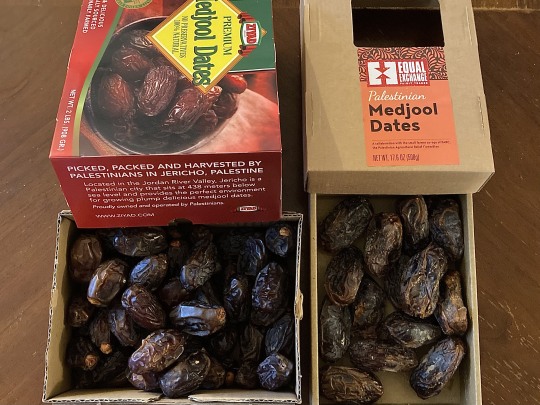
Instructions:
For the dough:
1. Melt margarine in a microwave or saucepan. Measure flours into a large mixing bowl and pour in margarine; mix thoroughly to combine. Rub flours between your hands for a few minutes to coat the grains in margarine. The texture should resemble that of coarse sad. Refrigerate the mixture overnight, or for up to 3 days.

2. Add dry ingredients to dough. If making both molded ma'moul and ka'k al-aswar, split the dough in half and add sesame and nigella seeds to one bowl.
3. Add water to each dough until you get a smooth dough that does not crack apart when formed into a ball and pressed. Press until combined and smooth, but do not over-knead—we don't want a bready texture. Set aside to rest while you make the filling.

For the filling:
1. Pit dates and check the interiors for mold. Grind all ingredients to a paste in a food processor. You may need to add a teaspoon of water, depending on the consistency of your dates.
To shape the cookies:
Divide the filling in half. One half will be used for the ma'moul, and the other half for the bracelets.
For the ma'moul:
1. With wet hands, pinch off date filling into small chunks about the size of a walnut (13-16g each, depending on the size of your mold)—or roll filling into a long log and divide into 16-20 even pieces with a dough scraper. Roll each piece of filling into a ball between your palms.
2. Divide the dough (the half without seeds) into the same number of balls as you have balls of filling, either using a kitchen scale or rolling into a log and cutting.
3. Form the dough into a cup shape. Place a ball of filling in the center, and fold the edges over to seal. Press the dough into a floured ma'moul mold to shape, then firmly tap the tip of the mold on your work surface to release; or, use a pair of spiked tweezers or a fork to add decorative designs by hand.

4. Repeat until all the the dough and filling has been used, covering the dough you're not working with to keep it from drying out. Place each cookie on a prepared baking sheet.
For the ka'k al-aswar:
1. With wet hands, divide the date filling into about 32 pieces (of about 8g each); they should each roll into a small log about the size of your pinkie finger.
2. Divide the dough (the half with the seeds) into as many pieces as you have date logs.
3. Take a ball of dough and flatten it into a thin rectangle a tiny bit longer than your date log, and about 3 times as wide. Place the date log in the center, then pull the top and bottom edges over the log and press to seal. Seal the ends.
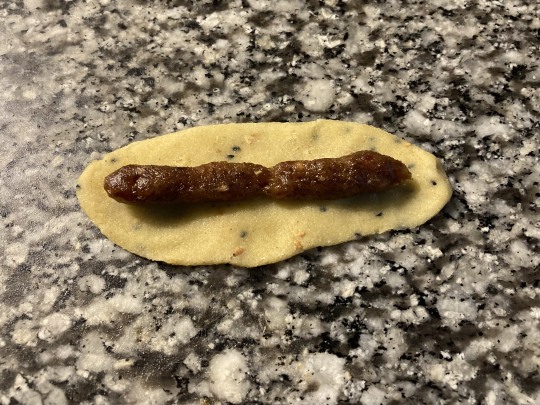
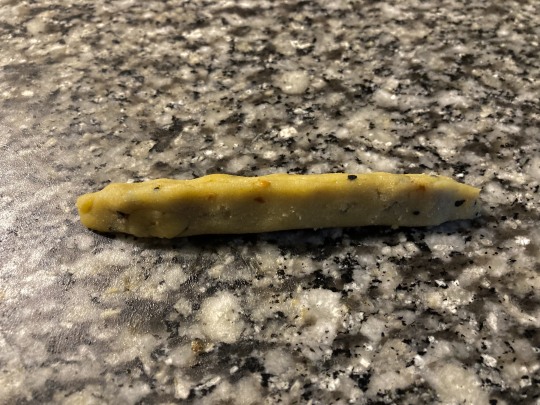
4. Roll the dough log out again to produce a thin, long rope a little bit thinner at the very ends than at the center. Press one side of the rope over the other to form a circle and press to seal.

5. Repeat until all the the dough and filling has been used, covering the dough you're not working with to keep it from drying out. Place each cookie on a prepared baking sheet.
To bake:
1. Bake ma'moul at 350 °F (175 °C) in the center of the oven for about 20 minutes, until very lightly golden brown. They will continue to firm up as they cool.
2. Increase oven heat to 400 °F (205 °C) and bake ka'k al-aswar in the top third of the oven for about 20 minutes, until golden brown.
Sprinkle cookies with powdered sugar, if desired. Store in an airtight container and serve with tea or coffee, or give to friends and neighbors.
327 notes
·
View notes
Text
The ramen shop was inherently ridiculous.
The humans had never eaten ramen. There was no reason for them to have ever eaten ramen. Humanity was mostly descended from inhabitants of Central and South America, who had absorbed the survivors of the United States of America, and most didn’t have the inclination or supplies for a lot of East Asian foods. They reproduced semolina through domesticating a worm that produced a frothy byproduct chemically similar to durum wheat, and they utilized a certain breed of fungus to experience the rapturous joys of beer. Semolina made easy couscous and fancier noodles, but it didn’t make great ramen.
So it made no sense to build a popular ramen restaurant in the upper districts of July. It didn’t stop them. It didn’t stop July from bulging with restaurants hawking alien foods and stores selling the novel and the obscene. Was that a video game store ?
The sheer amount of electricity this place ate up was insane. The sheer amount of wealth that its commerce was built upon: the assumption that your house had electricity, that your kids didn’t have ranch work and chores to fill their days. The video game was a large box with a screen on one end and a series of buttons and joysticks built into the side, and judging from the sample screens the game wasn’t very interesting, but - video games! What’s next, television?
In which shit hits the fan.
Sorry for the tremendous lateness - shit has been VERY insane over here. This chapter's a whammy, and I'm very interested in people's reactions. Next chapter is the finale. This chapter was I think the hardest to write, and the most difficult chapter of anything I've written in a long time. Vash is a nut.
25 notes
·
View notes
Note
Lentil Anon here, brought back from my academic wasteland by the picrew chain. may I suggest that you experiment with eating Cream of Wheat? it's nutritious and delightful. I recommend it lightly salted.
T
My wikipedia loop:
Cream of Wheat is an American brand of farina, a type of breakfast porridge mix made from wheat middlings.
[clicking the link]
Farina is a form of milled wheat popular in the United States.
[So I looked at the finnish page for "farina" to look up what it is in finnish. I am linked to the page for mannapuuro, a specific type of porridge. I look up what manna is in english.]
Semolina is the name given to coarsely milled durum wheat mainly used in making couscous, pasta, and sweet puddings.
[I am nowhere closer to figuring out what cream of wheat is. But now I know for sure that I do not know at all.]
8 notes
·
View notes
Note
Spaghetti (Italian: [spaˈɡetti]) is a long, thin, solid, cylindrical pasta.[1] It is a staple food of traditional Italian cuisine. Like other pasta, spaghetti is made of milled wheat, water, and sometimes enriched with vitamins and minerals. Italian spaghetti is typically made from durum-wheat semolina.[2] Usually the pasta is white because refined flour is used, but whole wheat flour may be added. Spaghettoni is a thicker form of spaghetti, while spaghettini is a thinner form. Capellini is a very thin spaghetti, sometimes known colloquially as "angel hair pasta", while Vermicelli refers to intermediate widths, varying between the United States and Italy.
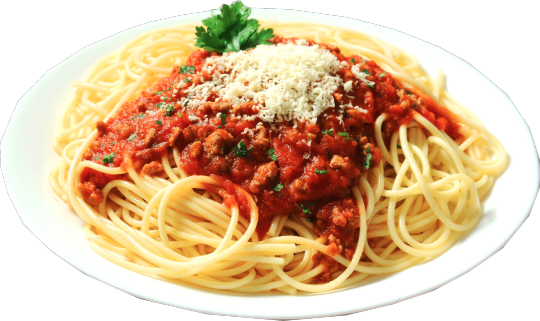
NOW LISTEN HERE YOU SON OF A BITCH- 😀

TOMMY I DON'T NEED TO LEARN ABOUT THE SPAGHETTI LORE. YOU LITERALLY JUST EAT IT THERE'S NO POINT IN LEARNING ABOUT IT SMH😭😭😭🤬🤬🤬🙄🙄🙄
#my asks#user: zombytommy#help I can't take this anymore 😭#TOMMY PLEASE-#I'M BEGGING FOR YOU TO STOP 🤬🤬🤬
4 notes
·
View notes
Text
German Vocabulary: Pasta!
die Auflaufform -- casserole dish
die Bandnudeln (pl.) -- ribbon pasta
die Eiernudeln (pl.) -- egg pasta; egg noodles
die Füllung -- filling
der Hartweizengrieß -- durum wheat semolina
die Lasagne -- lasagne
die Lasagneblätter (pl.) -- lasagne sheets
das Mehl -- flour
die Muschelnudeln (pl.) -- pasta shells
der Nudelauflauf -- pasta bake; noodle casserole
die Nudelmaschine -- pasta machine; pasta maker
die Nudeln (pl.) -- noodles; pasta
der Nudelsalat -- pasta salad
der Nudelteig -- pasta dough
die Pasta (pl.) -- pasta
das Salz -- salt
die Sauce -- sauce
der Schaumlöffel -- skimmer; slotted spoon
das Sieb -- sieve
die Soße -- sauce
das Speiseöl -- cooking oil
der Topf (pl. die Töpfe) -- pot; saucepan
das Wasser -- water
abbrausen -- to rinse
abgießen -- to drain
abschrecken -- to rinse with cold water
abseihen -- to strain; to sieve
abtropfen -- to drain
(etwas) ausrollen -- to roll out (something)
(etwas mit etwas) beträufeln -- to drizzle (something with something)
garen -- to cook
kochen -- to boil; to cook
schütteln -- to shake
sieden -- to boil
bissfest -- al dente
frisch -- fresh
gesalzen -- salted
getrocknet -- dried
glutenfrei -- gluten-free
kochend -- boiling
siedend -- boiling
sprudelnd -- bubbling
35 notes
·
View notes
Photo
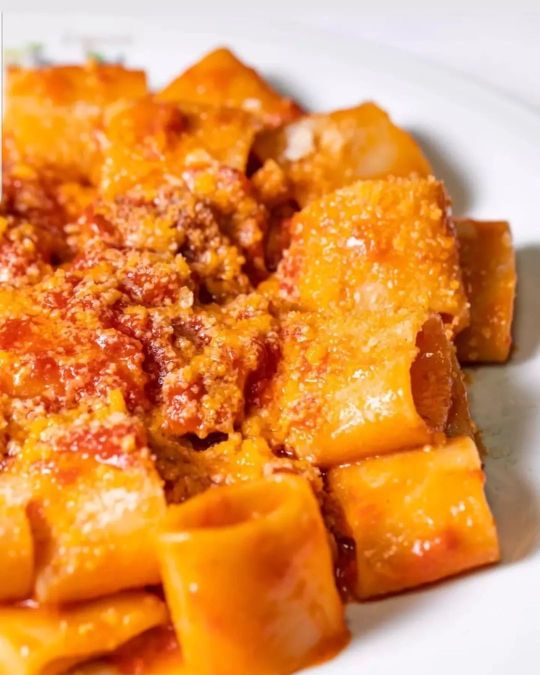
Homemade Paccheri - The origin of the name comes from the slap due to the noise they make when they are stirred in a pan with the seasoning sauce! . Ingredients: durum wheat semolina and water . #paccheri #pastafattaincasa #mamaisacookingschool #pastalovers #italy🇮🇹 #cucinanapoletana #cookingschool #cookingclass (presso Mama Isa's Cooking School) https://www.instagram.com/p/CqBFGsGoCnj/?igshid=NGJjMDIxMWI=
#paccheri#pastafattaincasa#mamaisacookingschool#pastalovers#italy🇮🇹#cucinanapoletana#cookingschool#cookingclass
9 notes
·
View notes
Text
Società Agricola Bio Maltento was born in the green heart of Italy, the Umbria region. It is here that high quality wheat is grown, it is here where the ancient art of cultivating our family fields has been handed down for four generations, for the processing of 100% Italian culinary products.
Umbria is the soul of our wheat, which contains its genuine essence. Our family is attentive to selection of the best wheat, grown according to the correct agricultural techniques and with respect for nature and our environment.
Durum wheat semolina pasta, of the highest quality with its pasta-making style based on the best bronze drawing and slow drying methods that maintain fragrance and a rough and porous texture, giving the real must of Italian pasta.
It contains a high quantity of fibers which contribute to the nourishment of vitamins and mineral salts, increase the sense of satiety and help to lower the glycemic load of a meal. Available in different formats, short and long.
Visit our Facebook and Instagram profiles or the website. Many thanks
.
#gualdotadino #biomaltento #italianagriculture #umbrian #localproducts
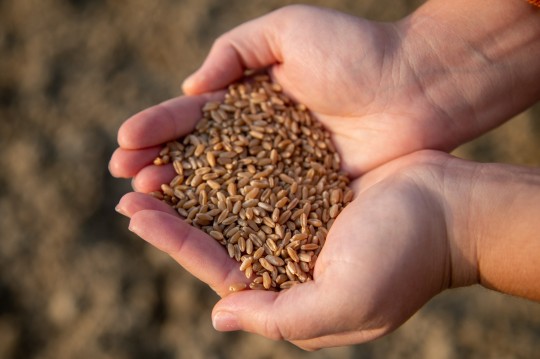

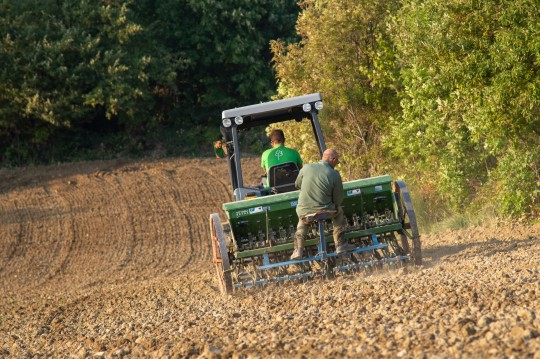
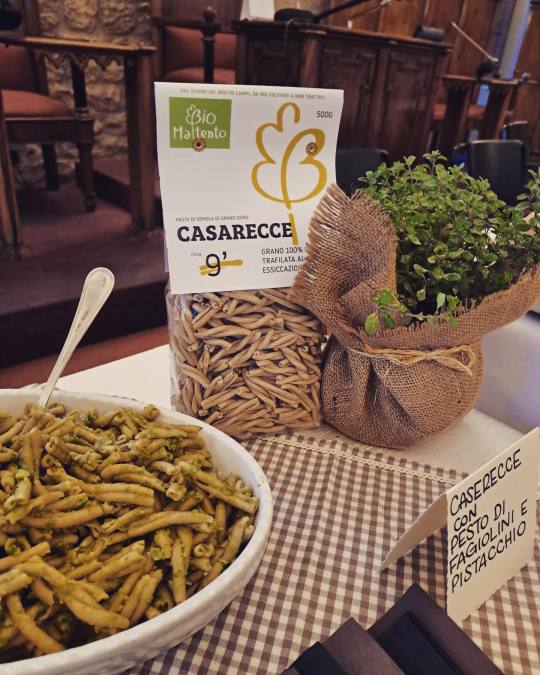



.
#umbria #visitumbria #umbriatourism #umbrianland #umbriaexcellencies
.
>PROUD TO SHOW UMBRIA<
3 notes
·
View notes
Text
out of curiosity I googled it and apparently shape is NOT the official difference?
Noodles and pasta differ primarily because of their ingredients and the type of processing involved, Kaminska says. Noodles are usually made with flour milled from common wheat. Pasta is processed from durum semolina, which is coarser than typical flour. However, that difference is not always so cut and dried.Jan 21, 2016
haha. cut and dried
2 notes
·
View notes
Text
So, as someone who's gluten intolerant, I get asked a LOT what foods I can eat.
I've also had people flat out tell me that foods that ARE safe for me to eat, aren't.
So, here's a handy little basic guide for all you people out there who don't know much about this, but are curious:
What Is Gluten?
Gluten is the name of a group of proteins often found in wheat, and some other grains. It's also the thing that makes your bread stick together and give that bready goodness, and help your foods stick together, like a kind of glue.
Foods That Contain Gluten:
Wheat
Wheat varieties and products like spelt, durum, semolina, couscous, farina, farrow, kamut, einekorn, wheat bran, wheat germ, emmer, seitan
Rye
Barley
Triticale
Malts (From barley)
Anything made with flour from the above grains.
Alcoholic beverages made with the above grains. (Most distilled drinks are fine, however, but that needs to be checked out on a case by case basis)
Crumbed and battered foods with the above grains.
Yeast, depending on source.
Foods That DON'T Contain Gluten:
Fresh fruits and vegetables.
Potatoes
Beans, seeds, legumes and nuts that are unprocessed.
Rice
Amaranth
Arrowroot
Buckwheat
Corn — cornmeal, grits and polenta labeled gluten-free
Flax
Hominy (corn)
Millet
Quinoa
Rice
Sorghum
Soy
Tapioca (cassava root)
Teff
Unprocessed meats. Like steak, chicken, pork...
Bacon.
Milk.
Foods That May Cause A Reaction:
Oats.
Yep, oats, while in themselves gluten free, (and apart from cross contamination issues, which can occur with all the above grains), have a protein called Avenin, which is similar to gluten, and can cause a reaction in some people like gluten would.
Seems easy enough to get around, right?
Wrong.
Remember I said above gluten acts like a glue?
Wheat flour is cheap.
Wheat flour is a very common thickener. I've personally seen it in ice cream, soups, stews, even soy sauce.
It's also used in a lot of corn or rice products, like crackers, tortillas, corn chips, noodles (yes, I've seen it in rice noodles), and sometimes the seasoning on potato chips. (There is nothing more infuriating than finding rice noodles containing wheat. It's just cost cutting, and stupid.)
Some of these products don't need wheat flour to hold them together, but wheat is cheap, and can bulk out other foods. It can also make sauces look better, and give a nice texture.
It's used in a lot of packet gravy mixes.
Barley is a commonly used flavouring. I've seen it in soups, stews, chocolate...
Yeasts can also contain wheat traces.
Even foods that don't have wheat as an ingredient, can contain traces.
A lot of processed foods have wheat in them. Again, cheap and glue.
Glucose syrup can be gluten free, depending on the source.
So basically, I have to read every label. Some products are gluten free, and then the company decides nah, and doesn't change the label (This has happened to me). Thankfully a lot of gluten free products label as such, so if you've seen foods you're sure are gluten free labelled that way, this is why. It encourages gluten free people to buy it, and the buyer doesn't have to read every freaking list of ingredients. Which is exhausting.
Things I've Had Ignorant People Argue With Me Over
You didn't think I was going to make a post like this without some humour in it, did you? Of course not! So here's the dishonour list, of conversations I've had.
"All potato chips contain gluten."
"Not the ones marked."
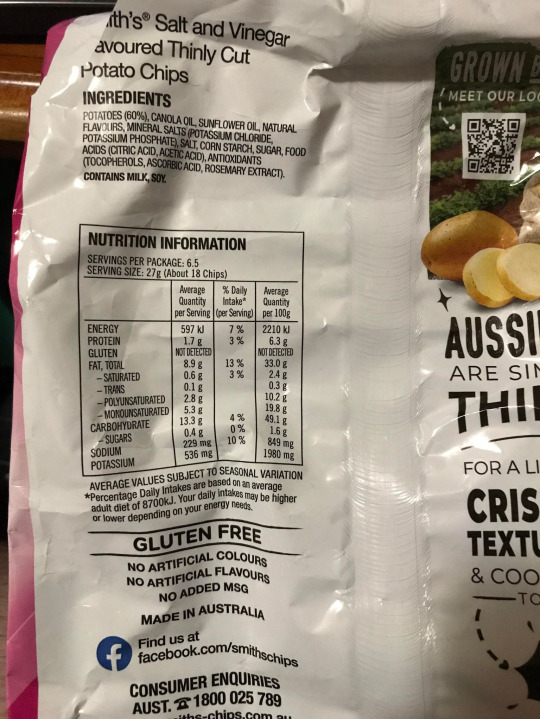
"Are you sure?"
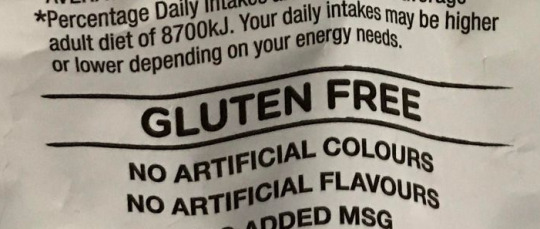
"What if they're just saying it?"
"They won't."
"Are you sure?"
"They'd get fined and/or sued. All allergens have to be listed by law."
"Rice isn't gluten free."
"Yeah it is."
"Nope, all grains contain gluten."
"Not all grains. Trust me, rice is gluten free."
"No, it isn't."
"Ok, I've researched the shit out of this, are you telling me I'm wrong?"
"Rice isn't gluten free."

"Oh."
"Yeah. Listen to me next time."
"Are you sure that avocado is gluten free?"
-blinking in astonishment- "Yes."
"You're sure?"
"Yes!" -pause- "Do you want me to google it for you?"
"No, I'm good."
"Vegemite is gluten free, they don't need to bring a gluten free version out."
"It's the yeast."
"They're just doing it to charge more."
"...They're the same price..."
"Yeast is gluten free though."
-three linked articles later-
"Oh. Why did you just tell me that?"
"Because you were arguing with me again, and it's more fun this way."
"Gluten free is healthier."
-extended laughter- "Nope. There's a lot of additions to try and mimic what gluten does."
"But it's all natural ingredients."
"Where did you hear that?"
"Everyone knows it. Because gluten free people like to be healthier."
"Trust me, it's not true."
"Everyone says gluten free is healthier."
"They're full of bullshit."
Sources for this post:
5 notes
·
View notes
Text
Flantse

Aostan cake made with rye flour, wholegrain flour, walnuts, almonds, candied orange, raisins, milk, eggs, butter and sugar.
Torta amara della Vallera

Piedmontese cake made with bitter almonds, sweet almonds, lemon zest, eggs, butter and sugar.
Torta Madesimo
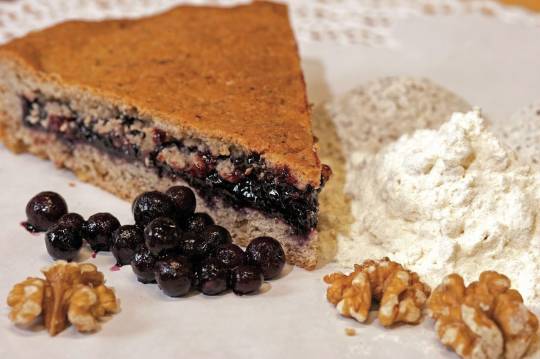
Lombard cake made with buckwheat flour, blueberry jam, walnuts, eggs, butter and sugar.
Pistiddu

Sardinian tart made with durum wheat semolina, Sapa (Italian most-based syrup), orange zest, lard and sugar.
Schiaccia alla campigliese

Cake from the city of Campiglia Marittima made with walnuts, pine nuts, lemon zest, eggs and sugar.
Dolce del Santo
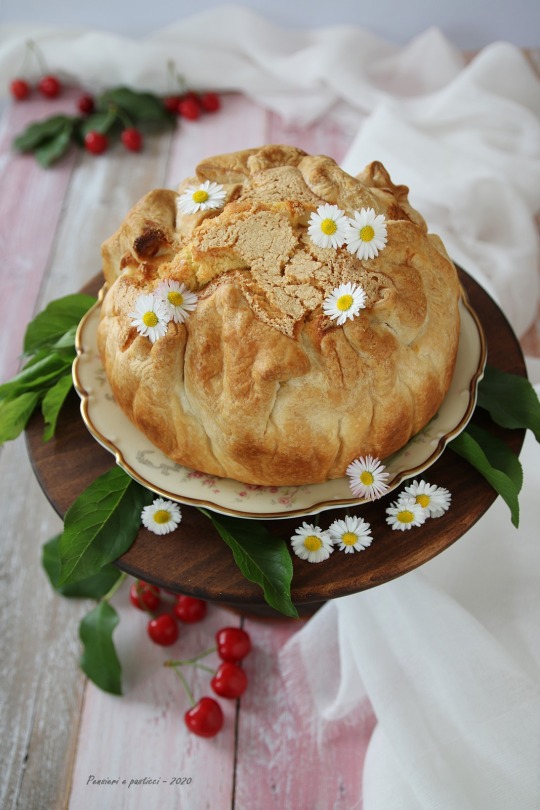
Paduan cake made with candied orange, candied citron, almonds, raisins, vanilla, apricot jam, eggs, butter and sugar.
Lou mécoulin

Cake from the city of Cogne made with raisins, rhum, cream, lemon zest, milk, eggs, butter and sugar.
Fugassa d’la befana

Piedmontese Epiphany cake made with candied fruit, raisins, vanilla, milk, eggs, butter and sugar.
Resta di Como

Easter cake from the city of Como made with candied orange, candied citron, raisins, honey, lemon zest, eggs, butter and sugar.
Biscotto di mezz’agosto
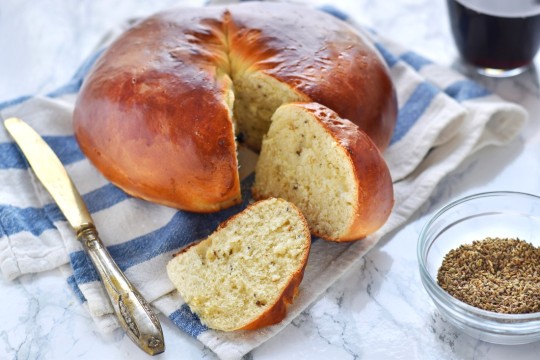
Tuscan cake made with sweet wine, aniseed, extra-virgin olive oil, eggs and sugar.
5 notes
·
View notes